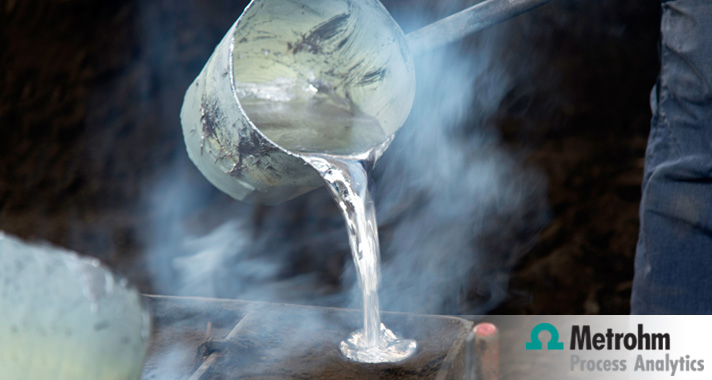Metrohm Process Analytics offers a fast, reliable online solution for the analysis of the total caustic, total soda, and alumina in Bayer aluminate liquors using thermometric titration.
Aluminium is used everywhere: in automobiles, bicycles, soft drink cans, cookware, and is even found in most antiperspirants, yet it does not occur in a natural state. Aluminium is a reactive base metal, and is mainly refined from bauxite ore, which contains approximately 60% alumina (Al2O3). To smelt aluminium directly from bauxite would be extremely costly due to its high melting point.
Analysis of Bayer aluminate liquors
The Bayer Process was developed in the late 19th century to extract alumina from bauxite, as purified alumina is much easier to smelt, and this cycle is still used by most alumina refineries today.
The bauxite ore must be finely ground in order to increase surface area, and then mixed with cleaned spent liquor, lime (CaO) and caustic soda (NaOH). This slurry is digested at high temperatures under pressure for several hours. The NaOH selectively dissolves the alumina as sodium aluminate. The CaO is added to the liquor to causticise carbonate, which enters the solution through degradation of organics in the bauxite as well as absorption of CO2(g) present in the atmosphere.
Analysis of the recirculating aluminate solutions is the single most important analytical task in the control of the Bayer Process.
Accurate and precise knowledge of the total hydroxyl (“caustic”), carbonate, and alumina values is required to maintain the highest process productivity from the supersaturated aluminate liquors while maintaining process losses at tolerable levels. Knowledge of the carbonate level is required to optimise the operation of carbonate removal processes, as well as adjusting its level with respect to the required causticity of the liquor.
Total caustic, total soda, and alumina in Bayer aluminate liquors
Metrohm Process Analytics offers a fast, reliable online solution for the analysis of the total caustic, total soda, and alumina in Bayer aluminate liquors using thermometric titration.
Thermometric titrimetry is ideally suited for industrial process control analysis. This method can be used for a wide variety of titration analyses and is well-suited to handle aggressive sample matrices because of the robust thermometric sensor. The sensor requires virtually no maintenance and because endpoints are located from the second derivative of the titration solution temperature curve, no calibration is required. Moreover, titrations are typically fast, leading to high analytical productivity.
Thermometric titration is a problem solver for difficult samples which cannot be titrated potentiometrically, and is also a preferred technique in situations when HF is present in samples.









